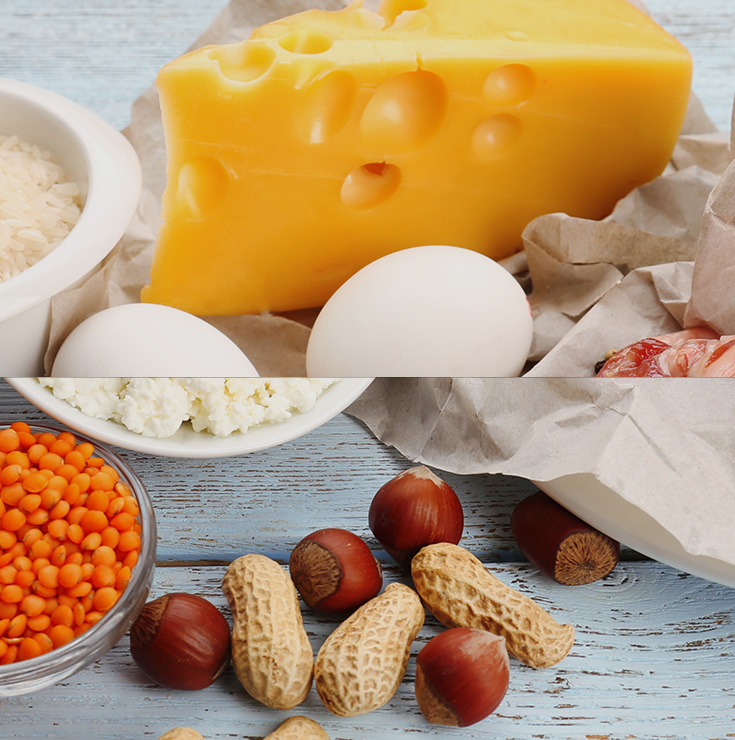Protein Guide for Beginners
Protein powder and bars are trendy supplements for bodybuilders to bulk up. But, is it really necessary for us regular folks to consume these products in order to lose weight and build muscle?
Before supplementing your diet with protein, determine if you are already getting enough from the foods you eat.
HOW TO DETERMINE YOUR PROTEIN NEEDS
Our body changes every day as cells grow, divide and die—these processes depend on protein to supply vital building blocks to our cells. Because of this, you need to eat enough protein to maintain lean muscle mass and support other important body functions, which you can read more about in Nutrition 101: Protein.
The recommended dietary allowance (RDA) predicts how much protein you should eat daily to guard against lean muscle loss. The RDA for protein is 0.8 gram/kilogram of body weight, but this is a minimum for the average sedentary adult, a.k.a. “weekend warrior.” MyFitnessPal calculates protein intake to be 20% of your daily calories, which is likely more than enough to maintain muscle mass. If you want to check, here’s how to calculate the minimum amount of protein you should be eating:
Step 1: Divide your weight in pounds by 2.2 to get your weight in kilograms.
Step 2: Multiply your weight in kilograms X 0.8 to get the amount (in grams) of protein you should be eating to maintain muscle mass.
If you exercise regularly—particularly if you log 1 hour or more of moderate to vigorous exercise several days per week—the International Society of Sports Nutrition recommends more protein. Their recommendation for an active person is to eat 1.2 to 2 grams of protein per kilogram of body weight on the days that you exercise. You can use the same steps above to calculate the amount of protein (in grams) you’d need on the days when you exercise.
For endurance activities (think swimming, biking, running), stick to 1.2 to 1.4 gram/kilogram.
For strength activities (think weight lifting), go with 1.4 to 2 grams/kilogram.
GETTING PROTEIN FROM WHOLE FOODS
If you’d rather reach for real food to meet your protein needs, we’re right there with you! Getting all your protein from food is super realistic. A sedentary woman weighing 127 pounds only needs a daily dose of about 46 grams of protein, which she can meet by eating 3 ounces of chicken breast, one large egg, a handful of almonds and a stick of string cheese.
You’re probably saying, “I can eat that!” For most people, this amount of food daily is no biggie. Your own needs might be different, of course, but to help you plan your protein, here’s a quick list of protein-rich foods you can reach for:
| FOOD (SERVING | Cal | Pro (g) |
|---|---|---|
| Skinless chicken (3 ounces) | 141 | 28 |
| Steak (3ounces) | 158 | 26 |
| Roasted turkey (3 oz) | 135 | 25 |
| Lamb (3 oz) | 172 | 23 |
| Pork (3 oz) | 122 | 22 |
| Salmon (3 oz) | 155 | 22 |
| Tuna (3 oz) | 99 | 22 |
| Shrimp (3 oz) | 101 | 20 |
| Lobster (3 oz) | 76 | 16 |
| Scallops (3 oz) | 75 | 14 |
| Food (serving) | Cal | Pro (g) |
|---|---|---|
| Pinto beans (½ cup) | 197 | 11 |
| Lentils (½ cup) | 101 | 9 |
| Black beans (½ cup) | 114 | 8 |
| Chickpeas (½ cup) | 134 | 7 |
| Black eyed peas (½ cup) | 100 | 7 |
| Quinoa (½ cup) | 111 | 4 |
| Green peas (½ cup) | 59 | 4 |
| Food (serving) | Cal | Pro (g) |
|---|---|---|
| Greek yogurt (6 oz) | 100 | 18 |
| Cottage cheese, 1% fat (4 oz) | 81 | 14 |
| Regular yogurt, nonfat (1 cup) | 100 | 11 |
| Skim milk (1 cup) | 86 | 8 |
| Mozzarella (1 oz) | 72 | 7 |
| String cheese, non-fat (1 piece) | 50 | 6 |
| Large egg (1) | 71 | 6 |
| Food (serving) | Cal | Pro (g) |
|---|---|---|
| Peanuts (1 oz) | 166 | 7 |
| Peanut butter (1 oz) | 188 | 7 |
| Almonds (1 oz) | 163 | 6 |
| Flax seeds (1 oz) | 140 | 6 |
| Chia seeds (1 oz) | 138 | 5 |
| Walnuts (1 oz) | 185 | 4 |
Protein charts courtesy of Today’s Dietitian
AN INTRO TO PROTEIN SUPPLEMENTS
When it comes to protein, most of us don’t need supplemental help and can easily meet our needs from a well-balanced diet, but if you have above-average protein needs and have a hard time getting enough from your diet, supplementation may be appropriate. You can sneak in additional protein with whole foods but, from a lifestyle perspective, there are a few reasons why protein supplements, in bar or powder form, may make sense:
1. CONVENIENCE: Protein powder and bars can provide a high-quality snack with approximately 20-30 grams of protein for refueling after a tough workout, or eating on the go.
2. COST: Depending on the protein supplement you buy, it may actually be more cost effective to use a supplement than purchase more pricey foods like meat and fish. Whey protein powder is about $10-15/pound but also has a longer shelf life than fresh, protein-rich foods.
3. FEASIBILITY: Vegan diets rely on plant sources to supply protein and require eating a variety of foods since plant sources rarely contain all of the essential amino acids. For vegans who exercise intensely or strength train, protein supplements may be a useful.
PROTEIN POWDER BASICS
When it comes to protein, quality matters. This is why scientists came up with the “protein digestibility corrected amino acid score” (PDCAAS)–yes, it’s a mouthful! This score tells you protein quality as measured by: 1) how “complete” the protein is and, 2) how easily digestible it is.
The PDCAAS scores protein sources from 0-1 with 1 being the highest. A score of 1 is assigned to egg white, which contains all 9 essential amino acids and is easily digested and absorbed. Ideally, your protein powder supplement should score as close to 1 as possible, but this depends on the source of protein it’s made from. Here are the 3 most common sources of protein that powers your powder:
1. Whey and casein (PDCAAS=1) are proteins extracted from milk that are “complete” proteins, easily absorbed by the body and relatively inexpensive. Plus, these milk proteins contain branched chain amino acids (BCAAs) to encourage muscle building during strength training. The downside is that this protein source is unsuitable for vegans and people with lactose intolerance or milk protein allergies.
2. Soy protein (PDCAAS= 1) is plant-based, contains all 9 essential amino acids and is inexpensive. Soy protein powder is a great alternative for vegans who can’t take whey or casein, but wouldn’t be ideal for those with soy allergies.
3. Other plant-based proteins: Pea (PDCAAS=0.69), rice (PDCAAS=0.47) and hemp (PDCAAS= 0.46) proteins score low on the PDCAAS because they don’t provide all 9 essential amino acids when taken as a stand-alone source, and the rice and hemp proteins are not readily digestible. For this reason, they are usually found together in a plant-based protein powder supplement mix. While these mixes can be hypoallergenic, we’d still suggest whey, casein and soy if you can stomach them.
3 Tips for Fueling with Protein Powder
1. Choose whey when possible. If you’re considering a protein supplement to increase muscle size and strength, whey is the way to go–as long as you don’t have milk intolerance. It’s an inexpensive, high-quality protein that is quickly usable by your muscles.
2. Log your protein supplements. Don’t forget that supplements (and the milk you mix it with) have calories, too, and can contribute to excess weight gain if you aren’t mindful.
3. Supplement with exercise in mind. Consuming protein powder alone won’t get you a lean, mean physique–you’ll still need to shape up with some push-up, squatting, and burpie fun.
PROTEIN BAR BASICS
Like protein powder, bar supplements use the same sources listed above to add protein into a portable snack. Unlike powder, bars generally contain more calories, carbs, fat, and sodium for any given amount of protein. However, this is because you’re expected to mix powder supplements with milk to add in more of the other macros.! Bars provide a quick,mindless, no-mix way of getting post-workout nutrition. This table will help you visualize the basic nutritional differences (but really read the label):
| Cal | Pro(g) | Carb(g) | Sugar(g) | Fat(g) | |
|---|---|---|---|---|---|
| Bars | 200-300 | 15-30 | 15-40 | 5-20 | 5-10 |
| Powder* | 80-200 | 15-30 | <10 | 1-5 | <5 |
3 Tips for Fueling with Protein Bars
1. Read the ingredients. This is usually not a pretty place, but if you’re going to eat it, then read it. Protein bars can hide processed fibers, sugar alcohols and artificial sweeteners. Make sure you’re okay with these before biting.
2. Log your bar supplements. Some bars are meant to replace a whole meal, and they have the calories to do it. Logging bars helps you stay the course for your calorie goals.
3. Supplement with exercise in mind. Bars vary widely in the amount of carbs they contain. Choose higher-carb bars (20+ grams per serving) when you engaged in vigorous aerobic activities (running, swimming, biking), and lower-carb bars (<20 grams per serving) for non-aerobic activities.
3 TIPS TO GET THE MOST OUT OF YOUR PROTEIN
No matter what source you choose to meet your protein goals, remember these 3 tips to help you get the most out of protein:
1. Spread protein out over all your meals. Protein-rich foods don’t come cheap, but you can maximize your body’s ability to digest, absorb and use protein by distributing it evenly throughout your meals and snacks. Just take the total grams of protein you need daily and divide it into the total number of meals and snacks you eat daily.
2. Eat protein immediately after a bout of exercise. Having a high-protein snack soon after exercise (ideally before the 1-hour mark) is best because this is when muscles are sensitive to nutrients that it can use to repair and grow.
3. Pair protein with carbs. This is especially important when you’re refueling after aerobic exercise (like running) since protein is needed for muscle repair and carbs are needed to restock your muscles’ energy stores. Remember, the macros like to work together.




